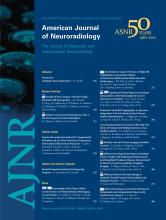Abstract
BACKGROUND AND PURPOSE: Patients with transfusional iron overload develop iron deposits in the pituitary gland, which are associated with volume loss and HH. The purpose of this study was to characterize R2 and volumetric data in a healthy population for diagnostic use in patients with transfusional iron overload.
MATERIALS AND METHODS: One hundred healthy controls without iron overload between the ages of 2 and 48 were recruited to have MR imaging of the brain to assess their pituitary R2 and volume. Pituitary R2 was assessed with a 8-echo spin-echo sequence, and pituitary volumes, by a 3D spoiled gradient-echo sequence with 1-mm3 resolution. A 2-component continuous piecewise linear approximation was used for creating volumetric and R2 nomograms. Equations were generated from regression relationships for convenient z-score calculation.
RESULTS: Pituitary R2 rose weakly with age (r2 = 0.19, P < .0001). Anterior and total pituitary volumes increased steadily up to 18 years of age, after which volume slightly decreased. Females had larger pituitary glands, most likely representing their larger lactotroph population.
CONCLUSIONS: From these data, a clinician can calculate the z scores for R2 and pituitary volume in patients with iron overload. Normal ranges are well-differentiated from values previously associated with endocrine disease in transfusional siderosis; this finding suggests that preclinical iron overload can be recognized and appropriately treated.
ABBREVIATIONS:
- GnRH
- gonadotropin-releasing hormone
- HH
- hypogonadotropic hypogonadism
- R2
- pituitary iron
- © 2012 by American Journal of Neuroradiology
Indicates open access to non-subscribers at www.ajnr.org












